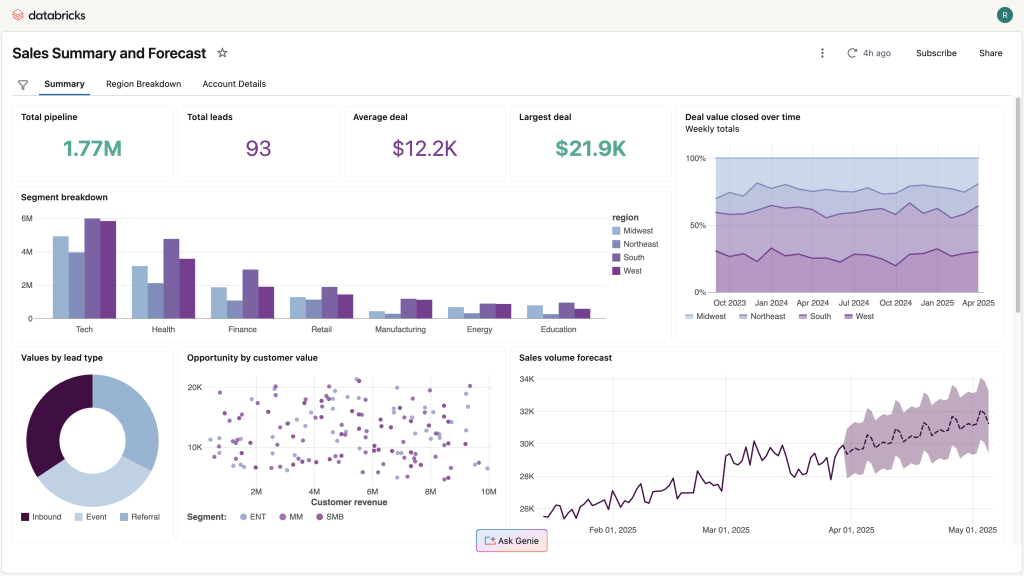Databricks, known for secure data storage and AI, has launched a new AI business intelligence dashboard called Databricks One, designed for nontechnical business users across various departments. While Databricks initially focused on providing secure data storage for large organizations (it works with 60% of the Fortune 500), it has in recent years shifted toward helping customers harness the power of AI models situated close to their data.
Until now, access to the Databricks platform was primarily limited to engineers and data scientists with SQL or Python skills. Databricks One introduces a completely redesigned interface, simplified specifically for users without a technical background.
“We want to make our experience for nontechnical users as amazing as our experience for technical users,” said Databricks cofounder and CEO Ali Ghodsi. “This is our first step of making this true so that everyone across the organization can unlock the full value of their data and drive innovation.”
The Databricks One tool resembles an AI chatbot interface. Users can describe the type of data or analysis they need, and a large language model translates those requests into actions. According to Ghodsi, this could involve deploying AI agents that tap into pipelines of various models and databases to retrieve data or perform specific analyses.
Ordinarily, such requests would require coding, but the dashboard handles that complexity for the user. “Behind the scenes it’s actually creating SQL and executing on a data warehouse, and all of that is abstracted away from you,” Ghodsi says.
To help users better understand the data, Databricks integrated visualizations directly into the One interface. Users can interact with an “AI/BI Genie” to refine their view, asking custom questions—not just selecting from preset queries offered by the dashboard.
A user might run advanced analytics on the effectiveness of a marketing campaign, conduct a legal review of overlapping (and potentially conflicting) business contracts, or quickly gather everything a salesperson needs before meeting a prospect.
Ghodsi says the idea for Databricks One came from many conversations with large enterprise clients. These organizations wanted to put AI-powered business intelligence into the hands of more employees who could act on it. At the same time, they were wary of the security risks involved in broadening access to potentially sensitive data on the Databricks platform. “Threading that needle and making sure that you have the right balance is very hard, and so we’re very excited we finally found the thing that works for all of our customers,” Ghodsi says.

Specifically, customers were concerned that nontechnical users might misinterpret the data, access information they shouldn’t, or use the platform in ways that couldn’t be properly audited. Many of Databricks’s clients operate in tightly regulated sectors like healthcare and financial services, where handling sensitive personal data is routine.
In response, Databricks spent two years building guardrails to address these risks. This included systems that assign different levels of access based on user roles and permissions. According to Ghodsi, the One platform keeps customer data secure and sandboxed, preventing leaks. Some users have read-only access, and the company does not use one customer’s data to train models for another.
Ghodsi believes the simplified interface could make the platform a strong fit for midsize and even small businesses in the future.
Following a massive $10 billion Series J raise in December 2024, Databricks has brought in about $14.4 billion in venture funding, along with $5.25 billion in debt financing, reaching a $62 billion valuation. Its value has grown rapidly as large companies try to use AI to mine their own data for actionable insights. In 2023, the company was valued at $43 billion—marking a roughly 44% increase in a single year during the so-called AI boom. Many analysts expect a Databricks IPO in 2025 or 2026, depending on market conditions.
Databricks One is currently in private preview, with a public beta expected later this summer. Ghodsi says the company won’t charge seat licenses but will instead use a metered pricing model based on usage time and token consumption by AI models.
Ghodsi says it’s ultimately up to customers to decide how widely to deploy the tools. “The litmus test is easy—are they like ‘Okay, let’s open it up to more people?’”
Autentifică-te pentru a adăuga comentarii
Alte posturi din acest grup

A dozen years after its launch, fintech company Chime rang the bell this morning at the Nasdaq MarketSite in Times Square to ce

It hits at a certain time in the afternoon, when a familiar craving strikes. You walk to the kitchen. The satisfying sound of a can cracking, the hiss of bubbles. It’s time for a “fridge cigarette

Many developers find that AI programming assistants have made writing code easier than ever. But maintaining the infrastructure that actually runs that code remains a challenge, requiring engineer


Fraudulent job applications have become a serious issue in the era of

With the first family actively engaged in memecoin ventures, speculation about the future of cryptocurrency has never been hotter. Laura Shin, crypto expert and host of the podcast Unchained

When Mike Krieger helped launch Instagram in 2010 as a cofounder, building something as simple as a photo filter took his team wee
